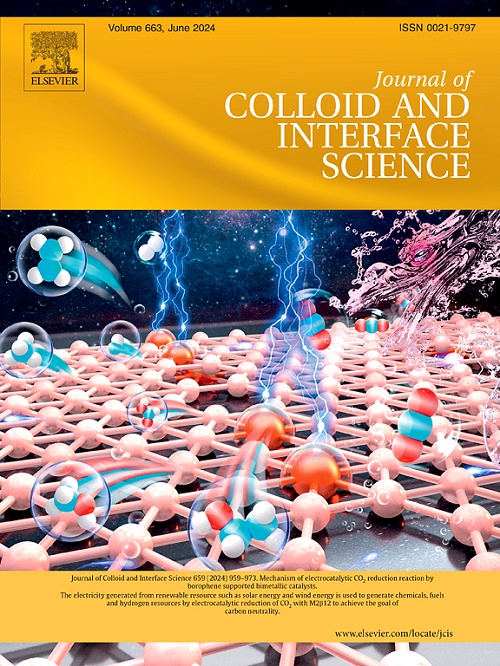具有高血糖触发级联酶催化活性的聚乙烯醇/葡聚糖自愈水凝胶促进糖尿病伤口愈合
IF 9.4
1区 化学
Q1 CHEMISTRY, PHYSICAL
引用次数: 0
摘要
高血糖引起的细菌感染、缺氧和氧化应激是糖尿病创面愈合的主要问题。葡萄糖激活级联反应通过消耗葡萄糖和消灭细菌,可以从根本上解决糖尿病伤口的这些问题。本文将葡萄糖氧化酶(GOx)固定在聚乙烯亚胺(PEI)吸附二硫化钼(MoS2)上,制备了MoS2-PEI-GOx (MPG)复合颗粒,并将其掺杂到聚乙烯醇(PVA)和葡聚糖(Dex)的自愈水凝胶中制备PD@MPG水凝胶。GOx可以将过量的葡萄糖分解为H2O2和葡萄糖酸,从而降低pH值,改善伤口微环境。低pH值使MoS2发挥类似过氧化物酶的作用,催化H2O2产生羟基自由基(OH)杀死细菌。在降低创面血糖后,MoS2可以起到类似过氧化氢酶的作用,催化创面处多余的H2O2转化为O2,从而缓解缺氧和氧化应激。此外,还通过体内实验对PD@MPG的伤口愈合能力进行了评价。本研究开发的自愈合水凝胶有望成为糖尿病伤口愈合的创新敷料。本文章由计算机程序翻译,如有差异,请以英文原文为准。

Self-healing hydrogel based on polyvinyl alcohol/dextran with hyperglycemia-triggered cascade enzyme catalytic activity promotes diabetic wound healing
Bacterial infection, hypoxia and oxidative stress caused by high blood glucose are the main problems in diabetic wound healing. The glucose-activated cascade reaction could fundamentally solve these problems in diabetic wounds by consuming glucose and eliminating bacteria. In this paper, glucose oxidase (GOx) was immobilized on polyethylenimine (PEI) adsorbed molybdenum disulfide (MoS2) to prepare MoS2-PEI-GOx (MPG) composite particles, which were doped into the self-healing hydrogel of polyvinyl alcohol (PVA) and dextran (Dex) for preparing PD@MPG hydrogel. GOx can decompose excessive glucose into H2O2 and gluconic acid, thereby reducing the pH value and improving the microenvironment of the wound. Low pH value enables MoS2 exert a similar role as peroxidase, catalyzing H2O2 to produce hydroxyl radicals (![]() OH) to kill bacteria. After reducing the blood glucose of the wound, MoS2 can play a similar role as catalase, catalyzing the excess H2O2 at the wound converted to O2, thereby alleviating hypoxia and oxidative stress. In addition, the wound healing ability of PD@MPG has been evaluated by in vivo study. The self-healing hydrogels developed in this study hold promise as an innovative dressing for diabetic wound healing.
OH) to kill bacteria. After reducing the blood glucose of the wound, MoS2 can play a similar role as catalase, catalyzing the excess H2O2 at the wound converted to O2, thereby alleviating hypoxia and oxidative stress. In addition, the wound healing ability of PD@MPG has been evaluated by in vivo study. The self-healing hydrogels developed in this study hold promise as an innovative dressing for diabetic wound healing.
求助全文
通过发布文献求助,成功后即可免费获取论文全文。
去求助
来源期刊
CiteScore
16.10
自引率
7.10%
发文量
2568
审稿时长
2 months
期刊介绍:
The Journal of Colloid and Interface Science publishes original research findings on the fundamental principles of colloid and interface science, as well as innovative applications in various fields. The criteria for publication include impact, quality, novelty, and originality.
Emphasis:
The journal emphasizes fundamental scientific innovation within the following categories:
A.Colloidal Materials and Nanomaterials
B.Soft Colloidal and Self-Assembly Systems
C.Adsorption, Catalysis, and Electrochemistry
D.Interfacial Processes, Capillarity, and Wetting
E.Biomaterials and Nanomedicine
F.Energy Conversion and Storage, and Environmental Technologies

 求助内容:
求助内容: 应助结果提醒方式:
应助结果提醒方式:


